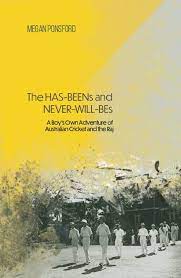The HAS-BEENs and NEVER-WILL-BEs
Martin Chandler |Published: 2022
Pages: 261
Author: Ponsford, Megan
Publisher: CricketMASH
Rating: 4.5 stars

Frank Tarrant was quite a cricketer. He never played in a Test match, although it is difficult to imagine that anything other than qualification rules prevented that. The Australian all-rounder only played ten full seasons of English cricket, but he did the double in eight of them, always by a comfortable margin.
The curtain came down on Tarrant’s playing career in England with the outbreak of the Great War, and with that he went off to India where he was employed by the Maharajah of Patiala. A great patron of Indian cricket the Maharajah had much to do with the development of the game on the sub-continent. His Highness provided money and enthusiasm, and Tarrant everything else.
But after he retired from any active involvement in the game the game largely forgot about Frank Tarrant, until the third decade of the twenty first century. In the last two years two books have appeared which have Tarrant as their centrepiece. First we had Mike Coward’s splendid biography, reviewed by me here and The Mac here, and now this one from Megan Ponsford. In fact it could be argued this is the third, Megan’s The Australian Cricket Tour of India: Breaking Down Social and Racial Barriers having been published in March.
The March edition is an expensive book from an academic imprint although, certainly in Australia, I understand it has attracted a good deal of interest amongst the cricketing cognoscenti. The HAS-BEENs and NEVER-WILL-BEs is, its publisher tells me, essentially the same book but completely reworked for a different audience.
The two writers’ projects have something else in common as well as Tarrant. Both were a long time in the writing. Mike Coward seems to have spent most of his adult life in pursuit of Tarrant. It wasn’t quite so long for Megan, a mere decade and a half, but in both cases the time was well spent. Both books are eloquently written, polished pieces of work and the depth of research that has gone into them is plain for all to see.
The subject of Megan’s book is the visit of the first Australian side to India, back in 1935/36. It wasn’t an official visit by any means, and indeed the Australian board were most anxious to avoid any suggestion that it was. No doubt in large part for that reason an interesting trip that lasted for the greater part of four months and included four representative matches amongst its seventeen First Class fixtures was granted a mere three pages in the 1937 Wisden. That fact is put in context by the 23 pages that were allocated to the visit of an official Australian side to South Africa for a five Test series, and the 18 occupied by the Sheffield Shield season.
The Board were, not unnaturally, anxious to ensure that no players who were needed for South Africa could tour nor, rather more disappointingly, any who would be needed for the Sheffield Shield campaign. The title of this edition of Megan’s book therefore highlights the team’s demographic. On the one hand there were some old stagers, skipper Jack Ryder (46 years of age), Charlie Macartney (49), Ron Oxenham (44), ‘Stork’ Hendry (40) and ‘Bert Ironmonger (53) to name five of those, and a selection of younger but tried and rejected players, one such being pace bowler Tom Leather, Megan’s uncle. Two other famous and newly retired players, Bill Woodfull and Megan’s grandfather Bill Ponsford, were targets of Tarrant but did not travel to India. Sadly Megan never gained any insights into the tour from ‘Ponny’, but her long standing fascination with the trip was fired by coming into possession of a box of Uncle Tom’s memorabilia.
The 1930s were interesting times in India. The British Raj still held sway and the tour was, effectively, bankrolled by the Maharaja of Patiala. Not surprisingly the entire trip caused great interest in India and was widely reported. There was therefore no shortage of material for the diligent researcher and Megan has done an excellent job of describing what was a groundbreaking venture played out against the backdrop of a political system and way of life that by then had only a decade to run.
One day I will have to make the effort to track down Megan’s book in its alternative form, but whatever may have been removed or added it cannot have resulted in any ‘dumbing down’ of the narrative. There is much beyond cricket in The HAS-BEENs and NEVER-WILL-BEs, a book that looks at the lives and careers of all the individuals that it features as well as defining the era in which it is set. As far as the cricket contest itself is concerned Megan is as strong on that as she is on the historical context. Despite everything the tour looked at one point as if it would be a story of constant success for the Australians. In the end however the Indians got the measure of their opponents and after losing the first two representative matches they won the third and fourth matches to square the ‘series’.
India’s position of strength in the world of cricket today is an interesting contrast to its status in the days of Frank Tarrant and the Maharajah of Patiala and for anyone wanting to take a look back at those very different times The HAS-BEENs and NEVER-WILL-BEs is highly recommended. It is a fine cricket book whilst, at the same time, being very much more than just a book about the game and its players.






Leave a comment